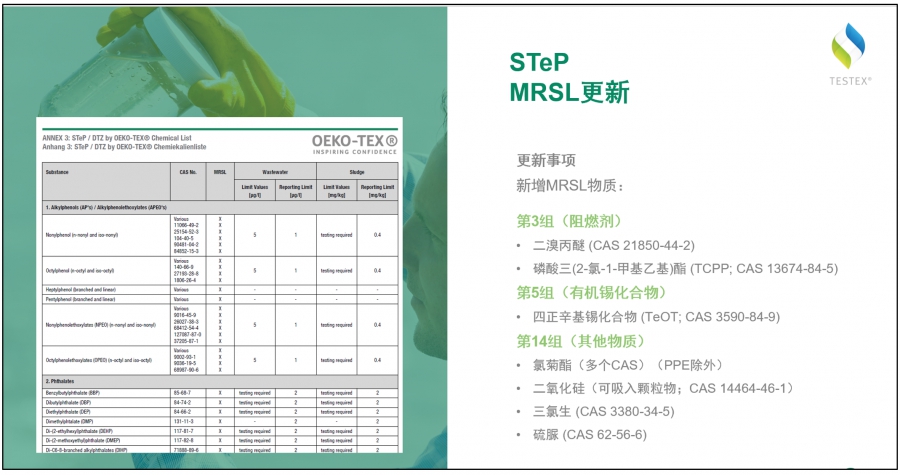OEKO-TEX® updated its existing certification service test standards and limit values at the beginning of the year, in line with consistent consumer protection and sustainable development of textile and leather products. After a 3-month transition period, all new regulations have officially come into effect on April 1, 2020.
1 New additions to the limit value catalog
After a one-year monitoring period, carcinogenic nitrosamines and nitrosated substances are now included in the STANDARD 100 and LEATHER STANDARD standards, and herbicides are now included in the STANDARD 100 and LEATHER STANDARD standards. Glyphosate and its salts are included in the limit list of STANDARD 100. STANDARD 100 and LEATHER STANDARD also stipulate total limit values for toxic heavy metals arsenic and mercury. Strict requirements for residues in textile materials will reduce the overall impact on the environment, workers and consumers.
2 New substances under monitoring
In 2020, OEKO-TEX® will monitor various new substances based on the latest scientific discoveries and with precise specification requirements. Based on the REACH regulations aimed at protecting human health and the environment, some substances with special hazardous properties and arylamines are newly classified as SVHC substances. Various dyes, pesticides and perfluorinated compounds involved will be rigorously tested.
3 New substances

Integrating DETOX TO ZERO into STeP by OEKO-TEX®
For a long time, in production plants The safe handling of chemicals and wastewater testing have always been important components of STeP certification. In response to the increasingly complex demands in textile and leather production, starting from April 1, 2020, DETOX TO ZERO will become a mandatory requirement for STeP certified factories that use large amounts of water and chemicals (wet processing plants). The positive impact of the new regulations is that STeP will comply with the Zero Discharge of Hazardous Chemicals (ZDHC) Manufacturing Restricted Substances List (MRSL) and the standards of the Greenpeace Detoxification Initiative.
For existing STeP customers involved in wet processes who have not yet started to implement the DETOX TO ZERO standard, there will be a transition period of 1.5-2 years (until the next certification cycle).
STeP/DTZ by OEKO-TEX® New substances in the chemical list

Now applicable to leather products
Since the introduction of the MADE IN GREEN label for textiles in 2015, this sustainability label will also be available from January 2020 Labels are applied to leather products. In 2019, we expanded STeP certification to leather product factories. OEKO-TEX® takes a step forward by integrating leather products with the MADE IN GREEN label. Leather products bearing the MADE IN GREEN label have been tested for harmful substances in accordance with the LEATHER STANDARD and are produced in environmentally friendly and socially responsible factories in accordance with STeP.
This allows consumers to trace the production factory and manufacturing country of leather products (such as clothing, footwear or furniture) through the unique product ID or QR code on the label. OEKO-TEX® also conducts audits of production plants through trained auditors to check whether the production plants meet the required standards. MADE IN GREEN has been listed by Greenpeace as one of the strictest labels on the market.
New design of MADE IN GREEN control panel
With myOEKO- With the release of the new TEX® platform, the MADE IN GREEN control panel has been redesigned. The control panel is now even more user-friendly, offering brands, retailers and manufacturers a variety of options:
•Create MADE IN GREEN products
•Generate MADE IN GREEN tags
•Manage MADE IN GREEN supply chain
•Perform assessments and set goals
Rename Phase I-III
OEKO- The TEX® Association will no longer use numbers and the different stages will be named: CAS number screening, analytical verification, self-assessment and on-site audit.
Self-assessment
The ECO PASSPORT multi-stage certification system is designed for manufacturers of chemicals and compounds. Especially when sourcing the right raw materials, labels provide transparent evidence that products meet standards for environmentally friendly textile and leather products.
The OEKO-TEX® Association is working to reconstruct the ECO PASSPORT certification process in order to provide customers with the best forward-looking service in the future. Currently, applicants can choose between standard ECO PASSPORT (CAS number screening and analytical verification) or ECO PASSPORT with additional self-assessment and on-site audit. From April 1, 2020, you can choose to pass a self-assessment instead of an on-site audit when applying for ECO PASSPORT. Achieve ZDHC MRSL compliance level 2 requirements by self-assessing and successfully following all regulations without the need for an on-site audit.
Strictly control the limit value
New substance
New monitored substances
LEATHER STANDARD is consistent with the updated content of STANDARD 100 in terms of more stringent limit values, new monitored substances, and new substances, but is different. There are changes in the whitelist.
The analytical tool DETOX TO ZERO by OEKO-TEX® is primarily designed for wet processing producers in the supply chain of the textile and leather goods industry. Comprehensive MRSL screening identifies hazardous substances, especially for wastewater testing.
To meet the increasingly complex requirements in textile and leather production, STeP by OEKO-TEX® companies that use water and chemicals on a large scale will from April 1, 2020 Must meet DETOX TO ZERO standards. DETOX TO ZERO MRSL is replaced by a harmonized chemical list applicable to DETOX TO ZERO and STeP. The list includes the latest MRSL requirements for chemicals, as well as wastewater and sludge requirements. The main advantage of the new regulations is future compliance with the ZDHC (Zero Discharge of Hazardous Chemicals) MRSL and Greenpeace Detox standards.
</p







